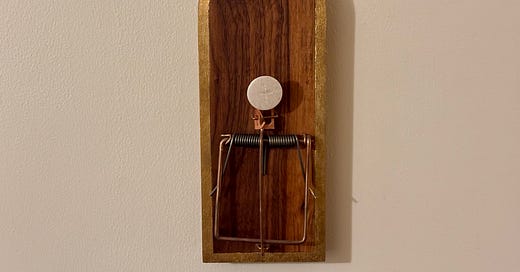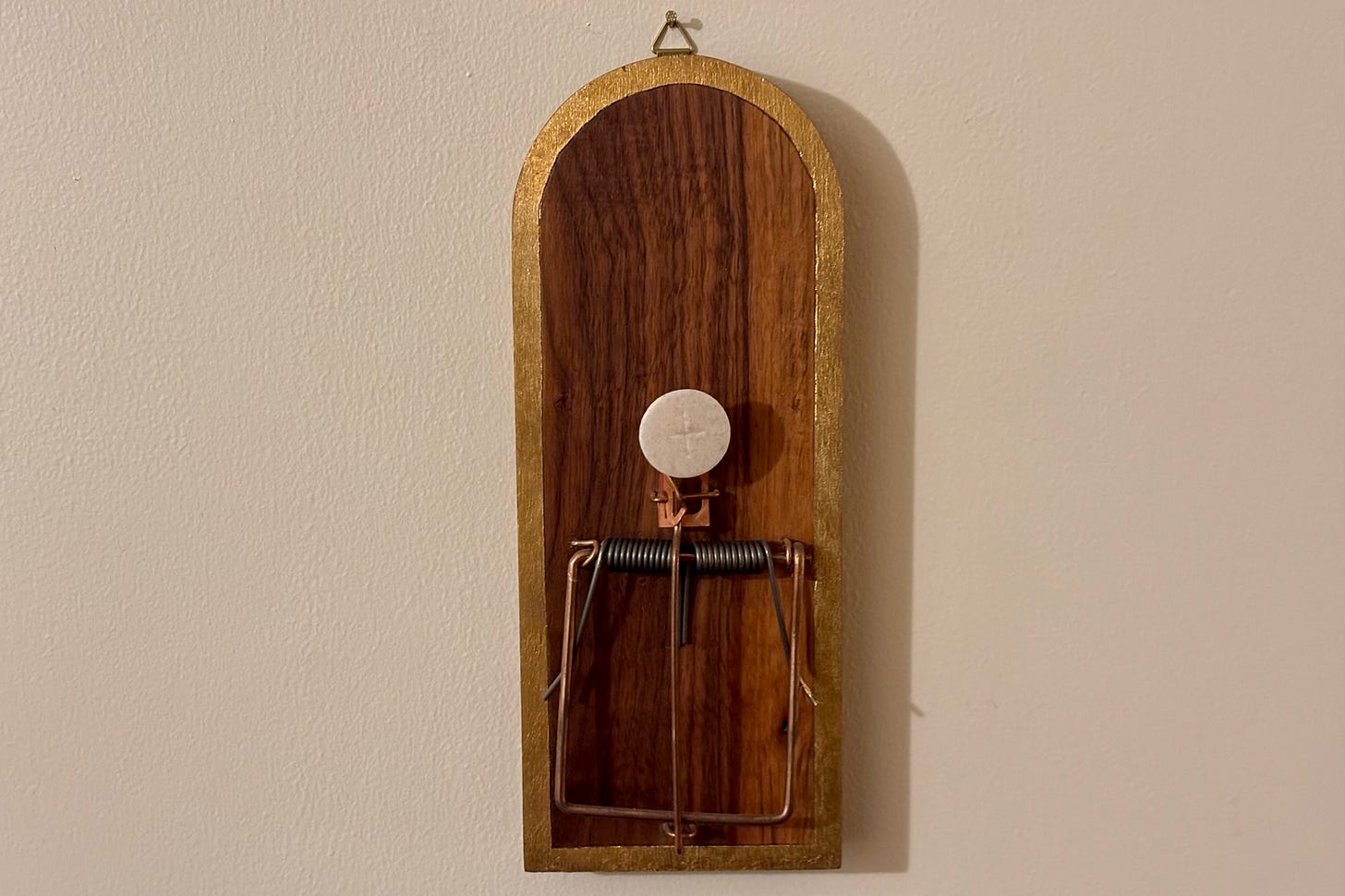Contemporary Art and the Crucifixion
In which a rat-trap crucifix helps us learn how to “read” art.
I have a live rat trap hanging on the wall above my bookshelf.
(If you think that’s weird, hold on a minute, because it’s about to get weirder.)
As I say, the trap is live. I’ve dutifully warned my wife and kids not to touch it, lest they lose a finger. If you touch it, it will get you. There’s bait on the catch, too, but it’s not a piece of cheese or a dab of peanut butter: it’s a communion wafer, an unconsecrated host.
If I’m about to lose you, faithful Christian reader, I completely understand. My friend Greg, who made the artwork, has about lost me a time or two, too. But among the highest praise I can give Greg is this: I trust him enough to follow him further down this road than I would typically go on my own.
The trap I set for you has caught my leg instead. (2021)
By Greg Lookerse
Greg Lookerse (pronounced loh-kers, like smokers) is a mixed media/interdisciplinary artist and an art professor. His Substack, Art Can Help, is truly one of the best articulations of a deeply Christian approach to art that I’ve ever encountered. Check it out here:
I confess that I’ve not been a fan of contemporary art. I read Rookmaker’s Modern Art and the Death of a Culture in graduate school, and I underlined and highlighted whole sections of the book with abandon. “Yeah!” said I. “Modern art is silly and ridiculous and self-serving and ugly!” I don’t understand contemporary art.
Greg understands it, though. He speaks a language I don’t speak. Hell, he thinks in ways that I can’t think. But I’m learning, bit by bit, to see even a shadow of what he sees. What’s more, Greg is a faithful Christian and a singularly brilliant mind. I don’t often feel out of my intellectual depth when talking to my friends, but Greg regularly leaves me floundering for the comfort of more familiar waters.
In addition to our casual conversations over pipes and beer, I’ve had the privilege of learning from Greg in more formal ways, too. Last year, he led me and a group of faculty members through a book called Modern Art and the Life of a Culture: The Religious Impulses of Modernism; it was a fascinating and capable response to Rookmaker, and Greg was a fascinating and capable facilitator. And when Greg exhibited his artwork in an installation at the local seminary, I was part of a small group that toured the exhibition with Greg and then went to the pub afterward to talk about the experience.
One more quick story, and then we’ll get back to the rat trap.
Shortly after we became friends, Greg invited me to a lecture he was scheduled to give on campus. “I’m going to convince you that Piss Christ is the best representation of the crucifixion you’ve ever seen,” he said. (I don’t remember if he said “best” or “truest” or “most beautiful,” but it was some such superlative.) I objected: Piss Christ is blasphemous. “But don’t you think Jesus’ crucifixion was blasphemous?” he said. Huh. I did. Beautiful and blasphemous. Is submerging a plastic crucifix in an artist’s urine worse than submerging the Son of God himself in the filth and excrement of my own sin? No, I don’t think it is. In fact, perhaps urine is the best way to communicate that particular truth. He who has eyes to see, let him see. I went to the lecture, and I saw. (If you’re curious, you can hear Greg talk about it here.)
Learning to ‘Read’ Art
The first time I walked into Greg’s studio, his rat trap piece immediately caught my attention. (The piece is titled The trap I set for you has caught my leg instead., from Greg’s series, “Things I Took From a Church On Fire.”) I asked Greg what it meant, and he immediately replied, “What do you think it means?” Ugh, I hate that question. I don’t know how to read art.
In an Art Can Help piece called “Depths: The Most Important Question You Can Ask,” Greg suggests that when we approach a work of art, we should ask three questions:
What do I see?
What does it remind me of?
What does all of that mean?
Let’s look at the rat trap piece again, and then run through each of these questions together.
The trap I set for you has caught my leg instead. (2021)
By Greg Lookerse
1. What do I see?
I see a rat trap mounted on a piece of wood with an arched top. The wood is stained and the grain is exposed, and around the outside edge is a border of gold leaf. The rat trap is live, and affixed to the catch or trigger is a single, round communion wafer with a cross on it. I also see in the mechanics of the rat trap an inexact sort of humanoid stick figure, with the host as a head, the spring as shoulders and arms, and a stick body down the center.
2. What does it remind me of?
Here’s what Greg has to say about this step:
This is usually where people become a bit intimidated. They are afraid that their personal associations are “wrong.” This illusion is the worst by-product of elitism in the contemporary “art world.” I want to let you know that it doesn’t matter if your associations and connections are not what the artist or curator or gallerist or professor wants/intends for you to “get.” You are allowed to have your own opinion. You don’t have to share it if it embarrasses you, but the real joy of viewing art is mulling over a piece and allowing yourself to find meaning through wrestling with what it reminds you of.
So, here we go:
The first thing I’m reminded of, both because of the shape of the wood and the gold border, is some of the sacred icons that I’ve seen. Except this time it’s not a beautiful painting of a religious figure, but a rat trap with a communion host. The shape also reminds me of a cathedral or church window, which suddenly seems important to me because I remember that icons are often talked about as “windows” — they’re something that you see through or that allows spiritual meaning or sight to pass through them.
The communion wafer also reminds me of experiences I’ve had taking communion in church. I think of the words of institution from Saint Paul:
“For I received from the Lord what I also delivered to you, that the Lord Jesus on the night when he was betrayed took bread, and when he had given thanks, he broke it, and said, “This is my body, which is for you. Do this in remembrance of me.” In the same way also he took the cup, after supper, saying, ‘This cup is the new covenant in my blood. Do this, as often as you drink it, in remembrance of me.’ For as often as you eat this bread and drink the cup, you proclaim the Lord’s death until he comes.”
—1 Corinthians 11:23–26
I’m suddenly aware of the connection between Jesus word, “remembrance,” and my current activity — I’m being “reminded of” or “remembering” things. I’m also doing this (looking at art) and remembering Jesus.
I think: This artwork has Christ’s body, but where is the blood? There will only be blood if I touch it. If there’s going to be blood, it’s going to be my blood. I don’t know what to do with that thought.
The piece reminds me of pain. I’ve never felt the pain of a rat trap, or even of a mouse trap, but I have felt pain before, and I’m reminded of that pain now. I can imagine what it might feel like to have my finger bruised or broken in this trap.
In similar ways, I’m reminded of surprise, as well as a sort of fearful anticipation that comes from wondering if or when the trap is going to spring.
I’m also reminded of an experience I had not with rats but with mice: I once found a nest of baby mice in my garage. There were maybe eight or 10 of them, young and hairless and innocent — but vermin nonetheless, and they needed to die. But how to kill them? Stomp on them? Smash them with a shovel or a rock? No, too bloody. I filled a bucket with water, dumped them in, put it behind the garage, and left them to drown. Several hours later, I went back to get rid of the dead mice and was surprised to see that one poor mouse was still alive, using the bodies of its siblings as a sort of grotesque raft to keep itself above the water. I pushed it under with a stick until the air bubbles stopped.
That story reminded me of a similar story a friend told me: He once trapped a rat in a garbage can full of water with dried corn floating on top. It was the same for him, though: The rat swam for an impossibly long time, staying afloat for hours. He, too, pushed it under to drown.
Both of these stories — and the artwork itself — remind me of death. That is, after all, what rat traps are meant to do: they kill rats. This is an instrument of death, which seems suitable, because the cross was an instrument of death, too. If the communion host is the body of Christ, then we see here the body of Christ on an instrument of torture and death. I’m ultimately reminded, then, of Jesus’ crucifixion: The host is a corpus, and this is a crucifix.
That’s a lot of things to be reminded of, isn’t it? What does it remind you of?
3. What does all of that mean?
The reminder at the end of my list in question 2 above — the reminder of death, I mean — calls to mind Paul’s warning in 1 Corinthians, immediately following the words of institution above:
Whoever, therefore, eats the bread or drinks the cup of the Lord in an unworthy manner will be guilty concerning the body and blood of the Lord. Let a person examine himself, then, and so eat of the bread and drink of the cup. For anyone who eats and drinks without discerning the body eats and drinks judgment on himself. That is why many of you are weak and ill, and some have died.
—1 Corinthians 11:27–30
Communing in an unworthy manner, without discerning the body, leads to judgment and, in some cases, death. So I think there’s a warning here that communion is not to be taken lightly. Under the wrong circumstances, it is deadly and not to be trifled with. (Under the right circumstances, though, it is life.)
I think it also means something similar to Bonhoeffer’s famous quote, that “When Christ calls a man, he bids him come and die.” The invitation to the Lord’s Supper — and it is an invitation — is an invitation to come and die. What better way to picture this than the sure and certain knowledge that grasping the body of Christ is going to trigger the trap to spring — SNAP! — and get me. This idea of dying in Christ’s death on the cross is, of course, deeply biblical:
“I have been crucified with Christ.”
—Galatians 2:20a“For you have died, and your life is hidden with Christ in God.”
—Colossians 3:3
In fact, we must die if we are to come to Christ. We must die to our sin, to our flesh, to the world: “Put to death therefore what is earthly in you” (Colossians 3:5). Come to Christ, then, knowing that you will die.
In an unexpected way, all of this strangely helps me to identify with the rat. This may sound a little excessive, but I think it’s in line with some of the biblical language like “worm” (Psalm 22:6) and “wretch” (Romans 7:24). When I face this artwork, I find that I’m the one reaching for the bait. I want Christ, and I know it will hurt, and I know I will die, and everything inside me, poor rat-bastard that I am, wants to flinch and pull away — but I reach for him anyway. What other choice do I have?
Finally, I find myself considering how we Christians too often sugar-coat the crucifixion, stripping it of its ugliness and horror and shock and blood — and the rat trap helps to strip away all of those nice illusions. Christ on the cross? I’ve pictured that a thousand thousand times. But Christ on a rat trap? That startles my imagination in new and intriguing ways.
Art Can Help
So, there you have it. That’s how Greg has taught me to “read” and to appreciate contemporary art. I’ll be forever grateful to him for it (not only for the lesson, but also for the art on my wall!).
And here’s the thing: He can teach you how to appreciate and read art in the same way. Seriously, follow his Art Can Help Substack — especially if you’re a Christian who’s interested in visual art or the arts or creativity or the imagination.
Greg really does believe that art can help. In this case, it has helped me see and consider Jesus’ crucifixion in deeper, newer, and more startling ways. I bet art can help you, too.
Please, subscribe below.
Subscribe to Josh Bishop writes.
And check out my other Substack publications:











I heard a quote that we need to "recruit imagination not just appeal to intellect" - This whole article and the artist's depth you've highlighted is a great testament to that. Great stuff.
Thank you, Josh. This writing is a gift we cannot possibly express our gratitude for. What a blessing you are, and we are grateful to have you in our lives.